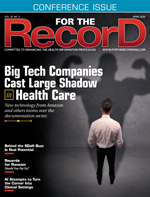April  2020
2020
Editor’s Note: Telemedicine Takes Center Stage
By Lee DeOrio
For The Record
Vol. 32 No. 3 P. 4
If ever there was a time for the HIT community to strut its stuff, it’s now. As the spread of coronavirus intensifies in the United States, all hands are on deck to do whatever it takes to lessen its stay. Well, the White House notwithstanding. As President Trump calls telehealth a “fairly new and incredible thing,” others more in tune with the technology’s history realize it’s been a long, difficult path toward gaining acceptance with the general population.
“Telemedicine has gained significant traction over the last few years, owing to its great utility as a time- and cost-efficient alternative to traditional brick-and-mortar medicine,” says Jonathan Wiesen, MD, founder and chief medical officer of MediOrbis. “In these critical times, telemedicine can help optimize the most valuable resource during a pandemic: physicians’ services. Moreover, and perhaps more importantly, telemedicine allows patients to be cared for without putting health care providers or patients at increased risk for spread of infection.”
The Trump administration has lifted several restrictions on telemedicine services for seniors covered by Medicare. In addition, some states have ordered payers to offer telemedicine services as part of their emergency plans while others have taken steps to ensure COVID-19 testing is covered via the technology. Plus, licensed clinicians can now prescribe controlled substances to patients they haven’t met in person, as long as they communicate using audio and visual elements.
Like most telemedicine companies, MediOrbis has been slammed with untold requests from patients looking for information and guidance. But the other side of the care equation has also been taking advantage of the technology.
“We have been inundated with requests from physicians who see their practices dwindling as patients are cancelling appointments en masse,” Wiesen says. “They realize that telemedicine must be utilized to continue to care for patients who are otherwise homebound due to local regulations or simply too afraid to venture out, particularly to a physician’s office. We took a consult the other day from a physician whose lung disease was worsening but who was too nervous to seek in-person care for fear of contracting a viral infection, fearing that, with his underlying lung problems, he’d be at high risk for complications.”
Could we one day look back at this time as being the point at which telemedicine gained its foothold and became more widely accepted as a care option?
“Absolutely,” Wiesen says. “People are never going to stop seeking in-person services, be it in medicine, shopping, or education. However, I believe that this moment is a wake-up call for people to see the great value that remote medical services—telemedicine—offers, and that it is indeed time- and cost-efficient. I cannot imagine people returning to traditional medicine with the same regularity once this situation is resolved.”



